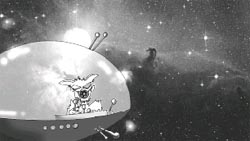Pollutants in space
 one would assume that carcinogenic compounds like polycyclic aromatic hydrocarbons ( pah s) were confined just to this world alone. But for nearly 20 years astronomers have been debating whether molecules of pah s are as common in space as they are on earth. pah s are customarily found in vehicular exhaust and cigarette smoke and are made up of two or more fused benezene rings.
one would assume that carcinogenic compounds like polycyclic aromatic hydrocarbons ( pah s) were confined just to this world alone. But for nearly 20 years astronomers have been debating whether molecules of pah s are as common in space as they are on earth. pah s are customarily found in vehicular exhaust and cigarette smoke and are made up of two or more fused benezene rings.
Scientists have been puzzled by the fact that certain interstellar gas clouds in regions of space too cold to produce thermal emissions nonetheless produce characteristic emission bands in their infrared spectra. These bands are astonishingly similar to the emission bands produced by pah s, but they are not exactly the same, and the failure of chemists to reproduce precisely the observed spectra in the laboratory has led some astronomers to argue that the emission bands are caused by small solid particles, such as soot or hydrogenated amorphous carbons. But recently astronomers going over data obtained by Europe's Infrared Space Observatory ( iso ), believe they have evidence of the presence of pah s in space.
Some astronomers claim that pah s could form in the atmospheres of carbon-rich stars and be ejected into interstellar space when the stars die. In the frigid conditions of space, such molecules would sometimes be struck by ultraviolet photons, causing the carbon atoms in the benezene rings to vibrate. Changes in vibrational energy are emitted as infrared light - a process called relaxation - just as a sound is emitted from a gong when it is struck. Because of the many different shapes and sizes of pah s, their spectra are dominated by bands of emissions, rather than discrete peaks.
Critics of this model argue that the emission bands just don't match those of pah s in the lab. "The spectroscopy obtained (in lab experiments) with solid materials, such as anthracite, give a better spectral agreement,' says Ce
Related Content
- Order of the National Green Tribunal regarding encroachment of the land marked as green area, Ghaziabad, Uttar Pradesh, 10/01/2025
- Order of the Supreme Court of India regarding severe air pollution in Delhi NCR, 18/11/2024
- Global State of National Urban Policy 2024
- Order of the National Green Tribunal regarding encroachment and deforestation of Senchal Wildlife Sanctuary, 10/04/2024
- Order of the National Green Tribunal regarding emission of high-level methane gas from landfill sites, India, 19/03/2024
- Order of the National Green Tribunal regarding violation of environmental norms during the execution of the Netravathi Waterfront Promenade Project, Mangaluru, Karnataka, 05/03/2024
